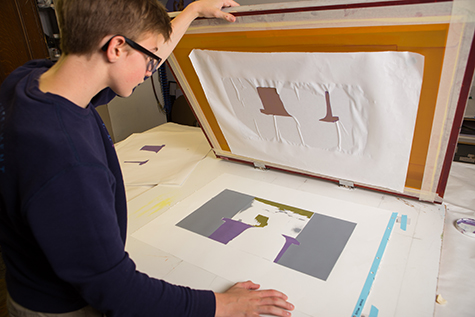ChatGPT said: 10:9 Design Screen Printing Texas: costs explained
The Crucial Guide to Recognizing Screen Printing and Its Versatile Uses
Screen printing has an abundant history that goes back to old times, advancing right into a sophisticated strategy utilized throughout different industries today. This overview discovers the complexities of the screen printing procedure, outlining its applications in advertising, home, and fashion design - 10:9 Design reviews. Comprehending these basics can open up creative potential for both commercial and artistic tasks. The following sections will certainly expose crucial suggestions and techniques to improve one's screen printing endeavors
The History of Screen Printing
Although screen printing has origins that map back centuries, its advancement shows the imaginative and technical innovations of different societies. Coming from ancient China, the strategy was originally made use of for embellishing textiles and later infect Japan, where it became indispensable to Ukiyo-e woodblock printing. The approach shifted to Europe in the 18th century, where it acquired appeal among artisans and business printers. The development of photo solution in the 20th century transformed screen printing, enabling more detailed layouts and better performance. Artists like Andy Warhol better propelled its appeal, making use of the medium to create legendary jobs that blended commercialism and art. By the late 20th century, screen printing had developed itself as a versatile strategy, used in vogue, marketing, and fine art. Today, it proceeds to advance, incorporating digital technology and increasing its applications throughout different industries.
The Screen Printing Refine Explained
Screen printing changes imaginative visions right into concrete styles with a collection of precise actions. At first, an image is developed and afterwards moved onto a screen, usually made from fine mesh textile extended over a framework. A light-sensitive emulsion is put on the screen, which is subjected to light, solidifying in areas not covered by the picture. After cleaning out the unhardened emulsion, a pattern is created.
Next, the screen is positioned over the substratum, whether it be material, paper, or an additional product. Ink is after that pressed through the open locations of the stencil making use of a squeegee, transferring the style onto the substrate below. This procedure can be repeated for several colors, calling for separate displays for each and every color. The published product is treated making use of warm to ensure the ink adheres effectively, resulting in a durable, vivid design all set for use.
Kinds of Screen Printing Techniques

Furthermore, specialty methods, such as discharge screen printing, get rid of color from the fabric to create softer prints, while foil screen printing applies metallic aluminum foil to achieve a glossy coating (10:9 Design Company). Each technique supplies distinctive attributes, dealing with various creative requirements and manufacturing scales, inevitably expanding the opportunities within the screen printing domain
Applications of Screen Printing in Numerous Industries

Furthermore, the signage and marketing fields use screen printing for creating captivating displays and banners. This method permits for vibrant shades and elaborate styles that record focus. In electronic devices, screen printing is used for applying conductive inks to motherboard, crucial for component links. The home design market welcomes screen printing to create distinctive designs on textiles and wall art. In general, screen printing functions as a critical tool throughout varied fields, boosting products with customized and visually attractive graphics.
Tips for Successful Screen Printing Projects
While carrying out a screen printing job, careful focus to information can considerably website boost the final end result. First, choosing high-quality products is important; this consists of the screen, inks, and substrates. Making use of proper mesh matters can influence ink deposition and information resolution. Preparation is just as important; comprehensive cleansing of screens and appropriate exposure times ensure crisp prints.
Next, accurate registration is important for multi-color prints. Utilizing positioning tools can help achieve exact layering. Furthermore, screening prints on scrap products prior to manufacturing helps recognize potential problems without wasting resources.

Frequently Asked Inquiries
What Materials Are Best for Screen Printing on Material?
Cotton and polyester blends are optimal for screen printing on fabric as a result of their resilience and ink absorption. Additionally, specialized materials like silk or canvas can generate one-of-a-kind textures and coatings, improving the general design top quality.
Exactly how Do I Tidy and Maintain Screen Printing Tools?
To preserve and clean screen printing equipment, one need to consistently clean displays with proper solvents, evaluate mops for wear, lubricate relocating components, and store all things in a completely dry, dust-free environment to prolong their lifespan.
What Are the Ecological Impacts of Screen Printing?
Screen printing can have significant environmental influences, including chemical waste from solvents and inks, water use throughout cleansing procedures, and power usage. Environmentally friendly products and lasting practices are crucial for minimizing these negative impacts.
Can Screen Printing Be Done in the house Successfully?
Screen printing can be properly done at home with the ideal products and strategies. Enthusiasts can develop high quality prints, though success depends on their ability degree, tools, and understanding of the procedure entailed.
What Are the Prices Related To Beginning a Screen Printing Service?

Beginning a screen printing business includes prices for devices, products, and work area. Initial expenses commonly vary from a few hundred to a number of thousand bucks, relying on the scale, quality of machinery, and preferred manufacturing capacity.
Screen printing has a rich background that dates back to ancient times, evolving right into a sophisticated method used across different sectors today. One more strategy, rotating screen printing, uses cylindrical displays, helping with continual printing on fabric rolls, consequently enhancing efficiency for large-scale productions. Furthermore, specialized strategies, such as discharge screen printing, get rid of dye from the material to produce softer prints, while foil screen printing uses metallic foil to achieve a shiny coating. In the fashion market, screen printing is extensively utilized to develop vivid styles on apparel, enabling brands to display their special designs. Cotton and polyester blends are perfect for screen printing on textile due to their toughness and ink absorption.